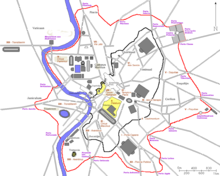City fortifications (Rome)
The city fortifications of the city of Rome have existed since the Roman royal era .
Antiquity
The first settlement center, known as Roma quadrata , only had city walls and other fortifications in exposed places . The around 500 BC The Servian Wall was erected in the 3rd century BC and was Rome's first comprehensive city fortification , which was built after the Celtic invasion of the year 390 BC. Was renewed and strengthened. Further developments induced Emperor Aurelian 270 to build a new city wall, the Aurelian Wall , which is still almost completely preserved today. At the beginning of the 5th century, Flavius Honorius integrated the Castel Sant'Angelo into the city's defensive system, reinforced the walls and expanded their gates into small fortifications.
middle Ages
The Saracen attacks of the 9th century prompted Pope Leo IV to protect the Vatican , which was then outside the city with the old Constantinian St. Peter's Basilica, with a new wall, the Leonine Wall . Starting from the Castel Sant'Angelo, it encompassed the Vatican and ended southeast of it on the Tiber . Under Nicholas III. Successful construction of the Passetto di Borgo , which connects the castle with the Vatican.
Modern times
The Sacco di Roma led to a reinforcement and a partial new construction of the Leonine Wall, whereby its northern course changed and included the district of Borgo . The Passetto was then within the walls. Under Urban VIII. Another wall was built along the Gianicolo , with which further settlements to the right of the Tiber were integrated into the defensive system of the city and their western flank beyond the river was better secured. The walls were the scene of battles in the Risorgimento , of which that at Porta Pia led to the end of the Papal States in 1870.
Fortress belt
Between 1877 and 1891 15 fortifications were built around the city of Rome to defend against possible French attacks. Due to the further development of artillery and the urban development of Rome, the facilities soon lost their original function. From 1919 they were only used as barracks or material stores. The systems are two to three kilometers apart and are four to five kilometers from the Aurelian Wall.
The list below starts at Forte Aurelio, west of downtown, and continues clockwise.
| Surname | construction time | Hectares | location | Current usage |
|---|---|---|---|---|
| Forte Aurelio | 1877-81 | 5.7 | ⊙ , onVia Aurelia Antica | Guardia di Finanza barracks |
| Forte Boccea | 1877-81 | 7.3 | ⊙ , on Via di Boccea | Former military prison |
| Forte Braschi | 1877-81 | 8.2 | ⊙ , Via della Pineta Sacchetti | Headquarters of the Italian foreign intelligence service |
| Forte Monte Mario | 1877-82 | 8.4 | ⊙ , onMonte Mario | military |
| Forte Trionfale | 1882-88 | 21.0 | ⊙ , on the Roman road of the same name | military |
| Forte antenna | 1882-91 | 2.5 | ⊙ , in theVilla Ada(Antemnae) | City of Rome, military |
| Forte Pietralata | 1881-85 | 25.4 | ⊙ , on theAniene | Barracks of the Granatieri di Sardegna |
| Forte Tiburtino | 1880-84 | 23.8 | ⊙ , onVia Tiburtina | military |
| Forte Prenestino | 1880-84 | 13.4 | ⊙ , on Via Prenestina | Alternative cultural center |
| Forte Casilino | 1881-82 | 3.8 | ⊙ , atCentocelle Airfield | Military, other uses planned |
| Forte Appio | 1877-80 | 16.5 | ⊙ , on theVia Appia Antica | military |
| Forte Ardeatino | 1879-82 | 11.2 | ⊙ , on Via Ardeatina | Park, fortress not accessible |
| Forte Ostiense | 1882-84 | 8.8 | ⊙ , onVia Ostiensis | Police office of the Stato |
| Forte Portuense | 1877-81 | 5.2 | ⊙ , on Via Portuense | Forte Portuense Cultural Association |
| Forte Bravetta | 1877-83 | 10.6 | ⊙ , between Via Portuense and Via Aurelia | Memorial to the victims of Nazi fascism |
literature
- Giorgio Giannini: I forti di Roma. Newton & Compton, Rome 1998. ISBN 978-88-8183-895-0
